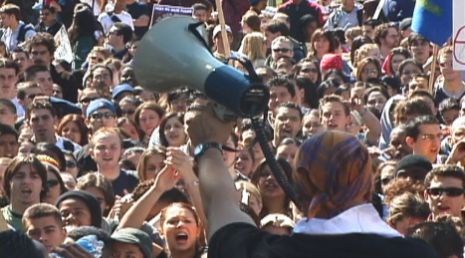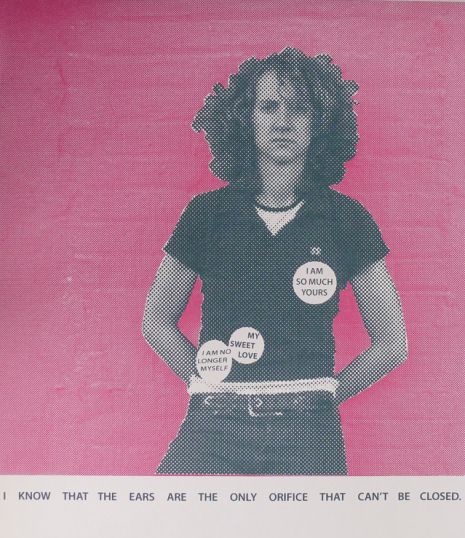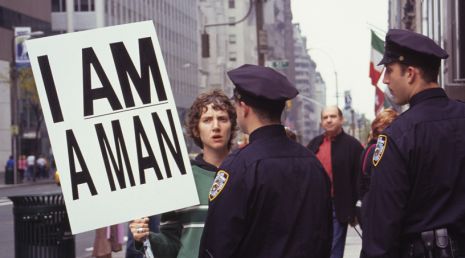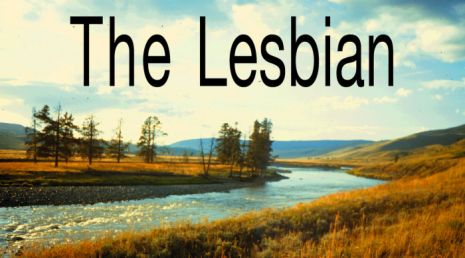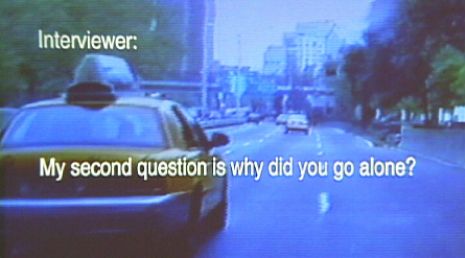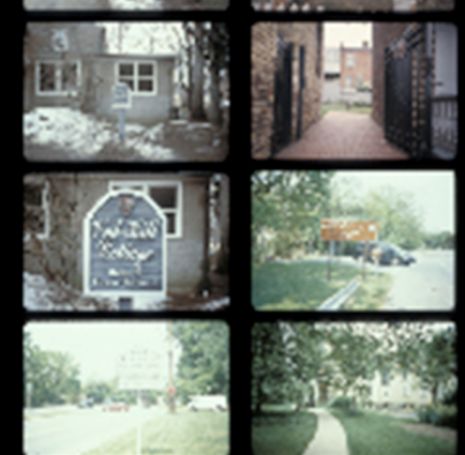Early Formations
Thanks to art historian Julia Bryan-Wilson* for her email interview with Sharon Hayes, conducted April-May 2013. Alpert Award panelist author and critic Kay Larson contributed earlier questions as well to Sharon.
I was 21 and coming directly from college. I went to Bowdoin College in Maine, was studying anthropology and doing some journalism and had to find a little relief from an overburdened schedule. I signed up for a class called The History of Performance Art because it was the only dance class that fit my schedule. It was being taught by a performance artist from New York City, Dan Hurlin. Three quarters of the way through the semester, I came to class late and, by way of apologizing, explained to him that all my plans to study away for my Junior Year had just fallen through. He immediately suggested I come to New York and be a rehearsal assistant for a piece he was doing with a choreographer named Victoria Marks.
Meeting Dan was a huge unexpected shift that – this may sound like a cliché - radically transformed my life. I came to New York, followed him into the downtown dance, theater and performance world, and met a whole community of queer and happy-to-be-with-queer artists and activists. That was, of course, in the middle of the AIDS crisis and that entry deeply marked who I became as an artist and a person.
Coming to New York in 1991, the crisis and the activism organized around the crisis was embedded in everything I encountered. I was following various threads like you do when you’re 21 and you land in a new place. Each thread led me to a place or a person or an event that was connected to, and affected by, the crisis. At first that was something I was just trying to understand, like I was trying to understand the performance scene I was entering. That is, an experience of finding yourself somewhere very specific and then slowly gathering an idea of what that place is. I started working for an artist service organization and had a chance to learn a lot about the work of a few artists, like Holly Hughes, who had been swept into the public political debate over cultural values and aesthetic production: the Culture Wars as they are called.
That organization also had a theater on East 4th Street. I went there because I liked it better than the office and I'd work with performance artists and dancers by running the light board or stage managing some performance evening. Everywhere in these encounters was the impact of the AIDS crisis.
The first work I made in that downtown dance, theater and performance context was in 1995 at the WOW café where I had gone to see things, and to work on shows for the Five Lesbian Brothers and other performers. If you hung around long enough, you were folded into the collective that ran the space and, from there, it was possible to propose a show. I made a theatrically based performance piece, a one-woman show, called Stalling. The form is sometimes called devised theater now. My first words were, "Hi, I'm Sharon Hayes,” and this initiated, for me, the start of an interrogation that has continued the whole stretch of my career: into the relationship between a speaker and a listener(s), into the permeable boundary between public and private realms and the process or conditions through which we construct collective identifications. In 1997, I did a piece called The Lesbian which was based on a three-and-a-half month drive I took across the U.S. to “discover lesbians in their natural habitat.” The Lesbian was essentially a 75-minute long conversation with the audience. It was the least theatrical piece I had done. The audience watched me - and only me - move props around the stage. There was no music to cover transitions, I addressed them directly, and even passed them a small tape recorder at one point, on which one of the ‘scenes’ transpired. After finishing that work, I didn’t know how to work in a theatrical context anymore. Other artists were able to make non-entertaining work using entertainment-based forms but I couldn’t figure out how to create the work I was moving toward making using those conventions.
Yes, you're right. I think they have totally different discursive formations but have been in communication with each other.
I went to study with Mary Kelly through, and as a result of my participation in, the Whitney Museum’s Independent Study Program in 1999-2000, which, by the way, was another moment of radical transformation. I met Mary there and then applied to UCLA to continue working with her. She has had a huge impact. Without hyperbole, I can say that I learned more from her than I did from any other single person I’ve encountered.
Mary has a very distinct, brilliant, method for interrogating a work of art that she uses in her teaching. Through this relationship I came to understand how to look at an artwork in terms of its formal and conceptual operations rather than in terms of judgment. She also insisted on looking at a work in relation to the institutional, formal and discursive systems in which it is positioned. This means in the space of a particular museum, with its precise architecture, institutional history and institutional investments, as well as in the context of a particular exhibition. I think there was a particular mutuality for those of her students, like me, who were born in the late sixties and early seventies, in part because we tended to have a heightened interest in those decades that were so formative and transformative for her.
She is an extraordinary artist and an extraordinary teacher and I am exceptionally lucky to have studied with her for three years.
My academic encounter with the social sciences engendered a deep skepticism in the investments that lie under the scholarly desire to analyze society and/or culture, primarily because that analytic lens was so often trained on a community outside of the scholar’s society or culture of origin. But I also gained a deep affection for, and fascination with, the earnestness and the awkwardness of conventional methodologies of social science: participant observation, the centrality of the informant interview, the transcripts of conversations and descriptions of observed behavior. I used these methodologies a fair amount in my early work perhaps because it gave me an excuse to talk to people, to ask them questions, to interview them or, as with The Lesbian, to suggest that I come to their town and perform in their living room. My approach was skeptical and ambivalent but not parodic.
I think I borrowed these methodologies of social science because I was looking for new representational forms that would allow me to dig into questions that I didn’t even realize I was asking: questions about collective desires that enact themselves through individual cravings, questions about the mechanisms and means of creating political identifications, questions concerning the deep contradictions that attend living in the United States.
I do both! I still have a sharp memory of once approaching a local library card catalogue (when libraries still used them) to look up the word ‘secret’ - an incredibly broad starting point for research on a new project.
In that open-ended model, I approach the search with an insanely expansive origin point but I usually am holding in my head an as-of-then-indescribable but far more specific idea. The open-ended research activities hold space for that thought or intuition to find its way to a form that I can write down and describe. So I definitely do things like ‘leafing through’ or ‘wandering about.’
But then there is also the obverse: trying to find a precise photograph or an exact text or specific interview.
I suppose the most uncomfortable research process was the one I engaged in Parole. For a long time I knew I was interested in making a video work that tracked a character that recorded sound but never spoke. It was a weirdly specific formal and narrative place to begin as it was completely lacking in any kind of focus or aim. I had no idea what I was interested in this character recording or why. At the same time, I had completed two performances in which I stood on the street speaking a love address: Everything Else Has Failed! Don’t You Think It’s Time for Love? and I March in the Parade of Liberty as Long as I Love You I am Not Free and was fielding a handful of invitations to perform those works or something like them internationally. I was resistant to that idea because the works I do in public space, or at least those works specifically, are so dependent on my knowledge of the public to whom I am speaking and my position within that public. Finally after saying no many times, I decided to say yes, but to also cast the sound recorder character of the new work, Parole, and to take her with me to London and Frankfurt and Istanbul to begin researching, by recording her, as a part of those performances. In the performances her presence is almost invisible but the video records of those performances constitute scenes in Parole. The collision of the two bodies of work, helped me learn what this position of the silent recorder could be and steered me to a more elaborate analysis of the conditions of deep listening and the way in which the body, Becca Blackwell, the actor in the work, organizes an operation of listening for a viewer.


